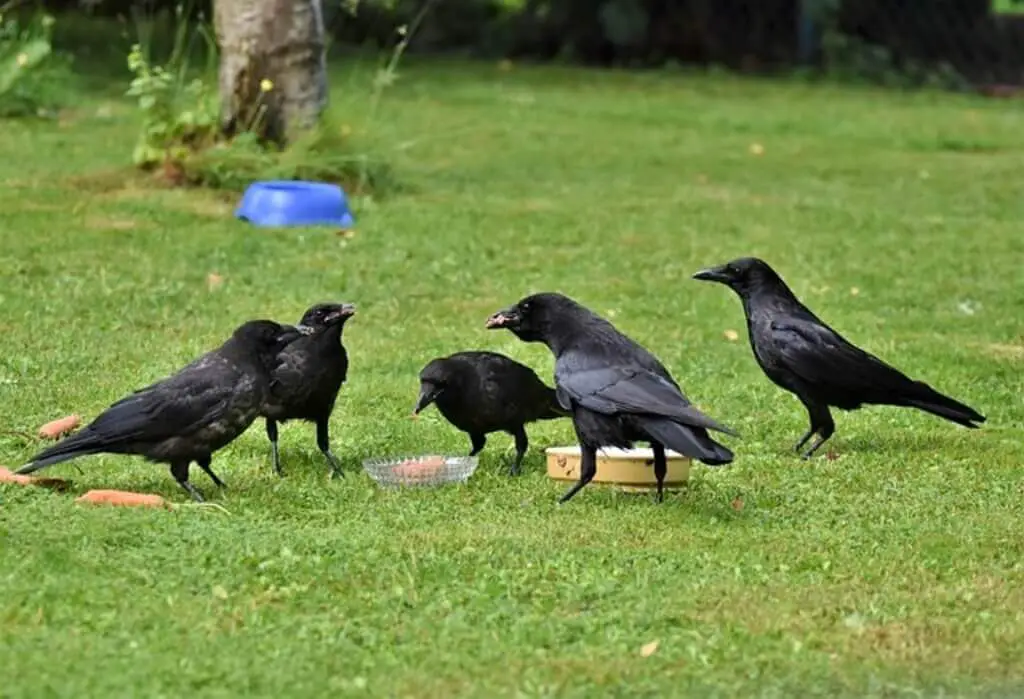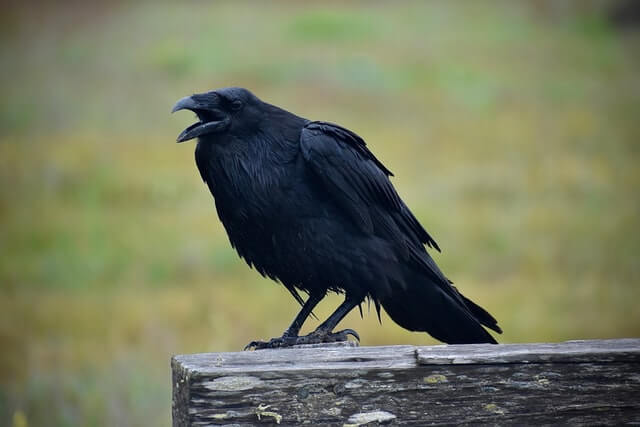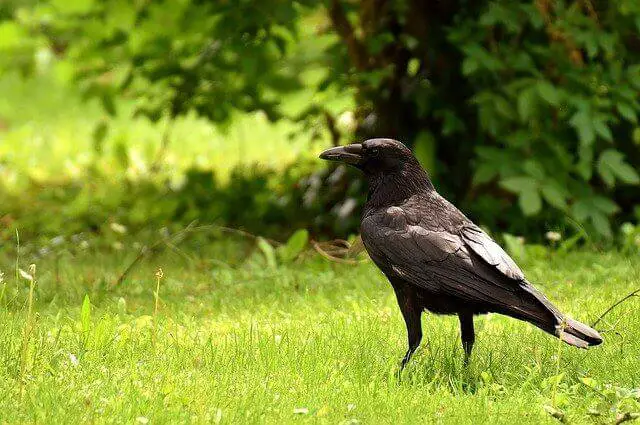Do you want to learn more about one of nature’s most mysterious creatures? Ravens have been captivating and inspiring people for centuries. With their intelligence, social behavior, and symbolic presence, they have come to represent a range of different things in culture.
To uncover the secrets behind these enigmatic birds, here are 47 fun facts about ravens that you may not know. From their diet to their unique communication skills, there is always something new and surprising to learn.
Table of Contents
- 1 Fun Facts About Ravens
- 1.1 Ravens were thought to be the messengers of Odin.
- 1.2 A Raven’s diet consists mainly of roadkill.
- 1.3 The Raven is a symbol for death in many cultures.
- 1.4 Ravens mate for life.
- 1.5 Ravens can eat one-third their body weight at a time.
- 1.6 Ravens, have excellent memories and intelligence.
- 1.7 Ravens are among the most intelligent animals on Earth.
- 1.8 Ravens are found in forests all over the world.
- 1.9 A Raven’s call can be heard up to 1 mile away.
- 1.10 A group of Ravens is called an “unkindness.”
- 1.11 Ravens have a vocabulary of 20 different sounds.
- 1.12 Ravens are not actually black.
- 1.13 A Raven can live about 30 years in the wild.
- 1.14 Ravens have an impressive brain-to-body weight ratio.
- 1.15 Ravens’ use vocalizations to communicate.
- 1.16 The call of a Raven is an expression of triumph and power.
- 1.17 Ravens are found all over the world except in Antarctica.
- 1.18 A male and female Raven can be distinguished by their beaks.
- 2 Author
Fun Facts About Ravens
- Length: 22.1-27.2 in. (56-69 cm)
- Weight: 24.3-57.3 oz. (689-1625 g)
- Wingspan: 45.7-46.5 in. (116-118 cm)
- Kingdom: Animalia
- Phylum: Chordata
- Class: Aves
- Order: Passeriformes
- Family: Corvidae
- Genus: Corvus
- Species: C. corax
- Binomial Name: Corvus corax (Carl Linnaeus 1758)
- Scientific Name: Corvus corax
- Range: The Common Raven is a large and powerful bird native to the Northern Hemisphere. It has a wide distribution range, covering much of North America, Europe, the Middle East, Asia and parts of North Africa. Common Ravens are found in numerous habitats including mountains, forests, grasslands and deserts. Common Ravens can be spotted at elevations up to 10,000 feet above sea level throughout their range, as they take advantage of high winds streams that aid in their flight.
- Migration: Common Ravens have long been observed to be highly intelligent and adaptable birds. Despite this, they are often not seen as migratory because they do not travel in large flocks like other migratory birds. However, some northern populations of Common Ravens do exhibit a seasonal wander southward during the fall and winter months. These wandering populations are thought to form due to the decrease in food supply or weather conditions present in their northern habitats.
- Habitat: In North America alone, Common Ravens are native to virtually every habitat type, but they do prefer certain types of terrain where their preferred food sources are plentiful. Common Ravens prefer open areas such as grasslands, tundra, or savannas with plenty of large trees for roosting and nesting. They also inhabit mountain regions with rocky cliffs or ledges that can provide shelter from predators and access to prey. The species also lives in deserts, cultivated fields near human settlements where there are trees for shelter and plenty of trash or insects to feed on.
- Diet: They are one of the most widely distributed birds in the world, so their diets are varied and differ from region to region. Their diet consists mainly of small animals such as rodents, insects, reptiles, amphibians, eggs and carrion; however they have also been known to scavenge garbage dumps for scraps of food.
- Global extent of occurrence: 137,000,000 km2 (399 428 089.5 sq mi.)
- Global Population: est. 1000000-2500000 mature individuals.
- European Population: Est. 1,220,000-2,320,000 mature individuals.
- Conservation Status: Listed as Least Concern (Population Stable).
- Lifespan: In the Wild: 10–15 years of age. – In Captivity: 40–50 years of age.
- Breeding Period: Between mid-February and late May.
- Incubation Duration: 20–25 days.
- Nestling Duration: 28-50 days.
- Chicks Fledge: 3 to 5 weeks of age.
- Clutch Size: 3–7 eggs.
- Number of Broods: 1 brood per year.
- Egg Color: A washed out greenish-blue color with brown spotting.
- Nesting Habits: Common Ravens build large nests constructed with sticks and twigs that measure up to two feet wide. The female lays three to seven eggs, which are incubated by both parents for 18–21 days. During this time period, both parents take turns sitting on the nest to keep it warm and protect it from predators or any other danger that may come close to their new family member’s home. After hatching, the chicks stay in the nest for an additional four weeks before they are able to fly away with their parents in search of food sources.
Ravens were thought to be the messengers of Odin.
Ravens were thought to be the messengers of Odin, but what does that mean? In Norse mythology, ravens are closely associated with death and battle.
Odin is the god of war and his two ravens Huginn (thought) and Muninn (memory) fly around in the world gathering information for him. They bring back news from their observations which he then uses to plan battles or tell people’s fates.
A Raven’s diet consists mainly of roadkill.
A raven’s diet consists mainly of roadkill. They are known to eat dead animals, eggs, insects and other small creatures they find on the ground. Ravens have also been observed to hunt live prey, such as rabbits or fish.
The Raven is a symbol for death in many cultures.
The Raven is a symbol for death in many cultures. The raven can be found in the myths and legends of multiple civilizations, including Norse mythology, Greek mythology, Celtic mythology, and American Indian lore. In ancient times, people believed that seeing a raven would signify an impending death or disaster.
Ravens mate for life.
Ravens mate for life. They typically form monogamous relationships with one partner for life. The male and female raven choose each other carefully, as they are unlikely to find another mate if the relationship does not work out.
Once paired up, the birds will stay together until death do them part. It is said that a raven’s cry signals its need for a new partner; if no one responds, it will fly off to die of loneliness.
Ravens can eat one-third their body weight at a time.
Ravens are omnivores, meaning they eat both meat and plants. They can eat as much as one-third their body weight at a time and will gorge themselves when food is plentiful.
They feed on carrion, invertebrates, eggs, insects, small mammals like rodents or rabbits, fruits such as wild blueberries or grapes, seeds from cornfields and various other sources of food.
Ravens, have excellent memories and intelligence.
Ravens have excellent memories which can be seen in that they use tools such as sticks to get food, caching (saving) for future use, remembering the location of a carcass or discarded food source from years ago, and even using simple symbols like objects laid out on the ground to convey information about danger.
Ravens are among the most intelligent animals on Earth.
The Raven is one of the most intelligent birds on Earth. They have the ability to solve complex problems, communicate with each other, and plan for their future needs. Ravens are really smart. They have an estimated IQ equivalent to that of a 7-year-old human child.
Ravens are found in forests all over the world.
Ravens are found in forests all over the world. They can often be found in the forests of North America, Europe, Asia and Africa.
A Raven’s call can be heard up to 1 mile away.
A raven’s call can be heard up to 1 mile away from its location. The sound they make is typically described as a series of hoarse croaks or caws that can last for over a minute at a time. This long period of loud noise helps other members of their flock know where they are.
A group of Ravens is called an “unkindness.”
One unusual fact about these birds is that they’re social creatures and live in large groups called “unkindnesses.” The largest recorded group had over 500 members! A group this size would use all their collective intelligence to find prey.
Ravens have a vocabulary of 20 different sounds.
They have a vocabulary of about 20 sounds that can be used to warn other ravens when danger is nearby or help locate food sources.
Ravens are not actually black.
Ravens are not actually black. They have a glossy blue-black color. When people see them, they often think that the raven is black because of its dark feathers and plumage. However, when you look closely at their wings, tail, head and beak they all have different colors on them from a deep purple to a soft pinkish-red.
A Raven can live about 30 years in the wild.
The lifespan of a raven is about 30 years in the wild; however, they have been known to live up to 50 years or more.
Ravens have an impressive brain-to-body weight ratio.
Ravens have an impressive brain-to2body weight ratio. For their size they have an unusually large brain with about 5 times more neurons than other birds which is thought to contribute to their intelligence and problem-solving
Ravens’ use vocalizations to communicate.
Ravens are birds that live in many habitats, but most often in mountainous regions. They have a wide variety of vocalizations and use them to communicate with each other.
Ravens can be heard making different sounds such as caws, croaks, growls, purrs, barks and chatters. Some raven calls are used for long-distance communication, while others act as warnings or alarms.
The call of a Raven is an expression of triumph and power.
The call of a raven is an expression of triumph and power. It is used to show dominance, superiority, or victory over another animal. The sound echoes throughout the forest signaling that it has won a battle against another animal and is in charge.
Ravens are found all over the world except in Antarctica.
Ravens are found all over the world except in Antarctica. They live on every continent except for Antarctica, but they have never been seen there. In North America, ravens can be found in almost any area of the country and have been seen in Canada and Mexico as well.
A male and female Raven can be distinguished by their beaks.
One can distinguish between a male and female raven by looking at their beaks. The male’s beak is slightly curved, while the female’s beak is straight.
Related Post:
- Why Do Birds Imitate Sounds? The Truth Finally Revealed!
- 14 Birds That Sound Like Car Alarms (Photos, ID & Info!)
References
- 2. Common Raven on All About Birds – https://www.allaboutbirds.org/guide/Common_Raven






